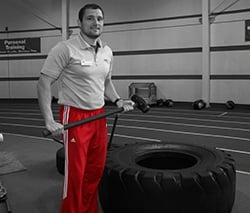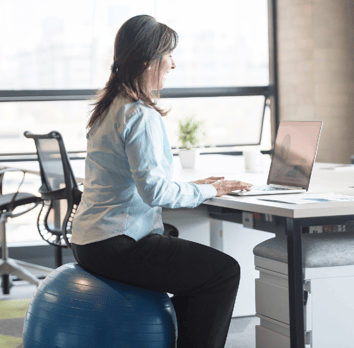Because we have all had a moment of “horror” at the gym, in honor of Halloween we thought it would be fun to reach out to our members and staff to compile a list of the most frightening scenarios that have actually happened to us at the gym.
What's my fitness horror story?
After a 13 day hiatus from all BODYPUMP™ due to my honeymoon I thought I would be fine jumping right back into class with the normal weight on my barbell. My new husband and I were active on the trip as we went hiking nearly every day and walked everywhere, but I we didn’t do any weight lifting. I felt fine during the BODYPUMP™ class, but boy was I in poor shape the 4 DAYS after! That is the MOST sore my entire body has ever been!

Now for some more frightening fitness stories from members and NIFS staff:
“I decided to run a half marathon without a single day of training and ran the entire distance in under 2:30. I could not walk for 2 weeks!!! Literally!!”
“During my first triathlon I made the mistake of only bringing one water bottle to the race. Within the first few minutes of the bike I dropped it and had no water for the rest of my ride leaving me extremely dehydrated for the run!” –Stephanie Kaiser, NIFS staff
“I trained hard for a trail marathon, my first marathon, eat right, got rest, was ready to go except……near mile 4 my foot/ankle twisted and I broke my 5th (outside) metatarsal, I had broken that foot when I was younger so I knew immediately, BUT I trained hard not just to run for 45 min. I tightened my shoe, hit all the ice cold creeks I could to “ice” the foot, and finished the marathon in just over 5 hours. Thanks to my friend Sarah I got thru (and she could drive me home).” Kris Simpson, NIFS staff
“Over a year ago I attended my third CrossFit class in where I performed the workout “Angie”. Less than a week later, and one week before my 30th birthday, I was in the ER being treated for Rhabdomyolosis a condition in which the muscle breaks down so much it enters the blood stream and can cause kidney failure among other consequences. Luckily my kidneys weren’t damage but I did “enjoy” a hefty hospital bill. From time to time I still deal with pain in my arms and the anxiety that I might have it again!” Penny Pohlmann NIFS Corporate Fitness Staff
“Do members that workout in their underwear count? I mean, I find it pretty horrific.”
“I joined a fun game of ultimate Frisbee while volunteering at a children’s summer camp. Unable to hold back my competitiveness, I tumbled over 3 children while sprinting and diving for the Frisbee. Needless to say, I didn’t catch the Frisbee and I fractured my ankle in the process!”
“I decided to try out a move I saw on “Biggest Loser” where you jump up onto an upside-down BOSU. I had pretty solid landings for the first few I tried, so I started to get cocky, and then fell off and twisted my knee. I wasn’t able to do cardio for about 2 weeks!” Michelle Meadows, NIFS Corporate Fitness staff
“In September 2009 I attended my very first spinning class. It was a great class, though I had no idea how to do most of the things we did, and indeed it was the very first time I had ever been on anything that resembled a bike in any way. I was 50 years old at the time and could barely walk up a flight of stairs, I was about 60 pounds heavier than I am currently. I DID make it to the end of the 60 minute class though my eyes were focused on the clock. As painful as the class was, the real pain was to come the next day, and for the 3 following days. It took my body close to a week to recover from that very first spinning class, though I was already hooked and went back :)”
“I trained like crazy for the ½ Flying Pig Marathon in Cincinnati. OH. I did a great job preparing for the hills on treadmills because we had a very cold, wet and snowy winter. Little did I know, you can’t really simulate going DOWN hills on a treadmill. It took 3-4 miles to climb this huge hill, but we were down to sea-level within 1 mile. Needless to say, my quads were burning so bad that I had to us the handicapped restroom at work all week because I couldn’t get up from the seat without a handle…fun-fun!! LOL!” Anne Murphy, NIFS Corporate Fitness staff
“A member was running a marathon, and at about mile 10 or so, nature #2 called. To make matters worse, this part of the course was through a residential community. Being an avid runner, they found a large neighborhood sign and took care of business. Funny enough, they went on to finish the race with a near PR.”
“I was teaching a group fitness class at a corporate site, and in the middle of class my shorts ripped at the seam while doing squats. Not wanting to disrupt class, I carefully angled my exercises and finished the last half.” Doug Trefun, NIFS Corporate Fitness staff
“I have to put inserts in my running shoes, and doing so I take out the padded insert that comes with the shoe. I went to a triathlon with my shoes packed in my bag and wore flip flops to the race. I took the shoes out at the race site and noticed the insoles were not in the shoes. There were in my shoes at my sister’s where I stayed. I had to wear the shoes with no insole and it felt like I was barefoot! After 4.5 miles my foot hurt and I was later diagnosed with a stress fracture.” Kris Simpson, NIFS staff
“I was performing step-ups on stairs, without shoes. I landed wrong and broke my foot. I couldn’t do lower body exercises for over six months!”
“Like forgetting your shower towel and only discovering after your work out and when you are supposed to be at work in 45 min.? (Also, I was carpooling with Mike and was dropped off, so going home to shower wasn’t an option) AHHHH the horror…. Drying off with the hand towels provided by Wellpoint at the sink is less then idea…. BUT I got a work out in!“
“I did water aerobics at Gold’s Gym and I thought this would be the easiest workout in the world, well I was fooled. I was the youngest person in the pull and slowest. We had to do a figure eight running up to the top of the pool and all the older (elder) classmates were on their way back to the other side and I was still near the starting point. I felt like I was in a dream running as fast as I could but not moving anywhere. I was totally exhausted after that one hour of water aerobics. “
“I went to an offsite exercise class and was trying to challenge myself. When it was time to do this one particular drill over half the class left out to walk laps outside because it was hard for some to do. Well, I decided to do it and it ended with me running into the wall and in the emergency room with a broken finger. Needless to say that finger will never be the same.”
“When in Denver I decided to start getting fit I walked to work did ok going to work it was 12 miles, going home I was almost crawling by the time I got there my feel and knees were dying, I am over weight, I was limping the next 4 or 5 days and had blisters on the balls of my feet. ouch.”
Now it’s your turn:
What is one of YOUR fitness horror stories? Share it here!
This blog was written by Tara Rochford, NIFS Membership Manager, Group Fitness Instructor and author of Treble in the Kitchen. Meet all of our NIFS Bloggers.











